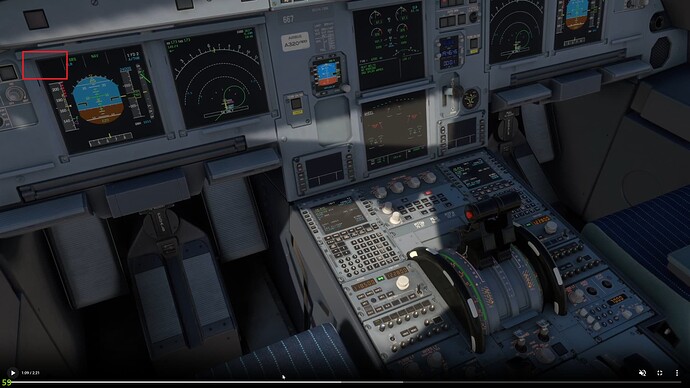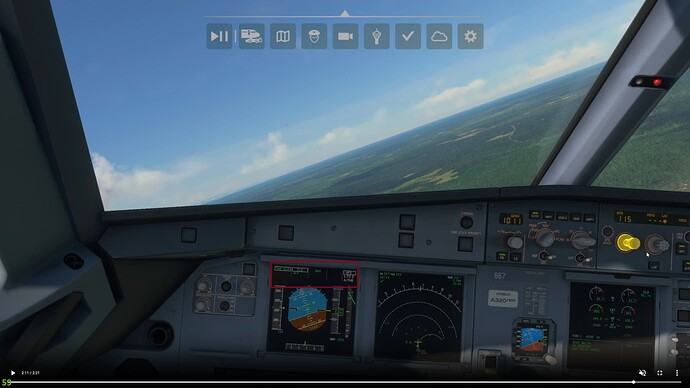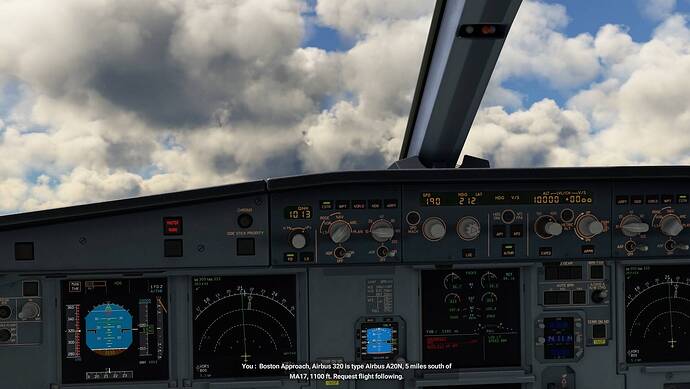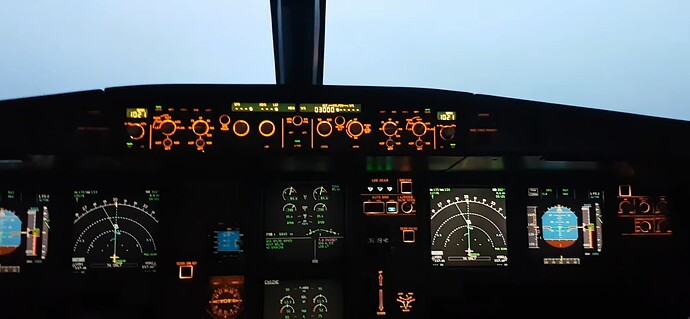No problem! We understand that these aircraft are very complex with their logic, and users may be used to how something is modelled on another similar aircraft type by a different developer, which may not be correct itself. It’s great we can have these discussions about complex logic for a default airliner! 
Thanks
The MSFS Team
1 Like
Hasn’t proved anything. I’d like to know what a test pilot would say.
I think you need glasses – in the video when he pulls back the levers to the CLB detent the auto-thrust button remains on! And no amount of pressing it changes that.
There’s no need to be rude. You can see in the video when the thrust lever is moved to the CLB detent that the FMA indicates that the Auto Thrust has disengaged as shown in the red box with the screenshot from the video below:
A/THR is in blue on the right hand side of the PFD, which indicates it is armed and not active. It returns to a white colour later in the video when THR CLB is activated once passing the Thrust Reduction altitude and the Auto Thrust is engaged again as shown in this screenshot:
In MY picture I am also showing the A-THR button on the FCU.
It is ON.
Whereas on the PFD it indicates that A-THR is not activated.
The A/THR button on the FCU being illuminated does not necessarily mean that it is active. Looking at your screenshot above you can see “MAN THR” on the top left of the PFD, which means manual thrust. You’ll also see A/THR in blue on the right side of the PFD meaning your auto thrust is armed. There’s a big difference between A/THR being armed and being active, which can be the case when the A/THR button is illuminated on the FCU! This is why it’s so important to read your FMA on the PFD 
Here’s a picture from a real aircraft, where you can see the A/THR button illuminated but the A/THR is only armed in blue, not active in white on the PFD.
And is pressing the A-THR button supposed to have no effect then?
(levers are in CLB detent during this)
Yep exactly that! The only thing pressing the A/THR button on the FCU would do is disarm the auto thrust if it is armed in blue and not active in white. 
Pressing the A/THR button on the FCU would engage the A/THR engage but only once you are passed the thrust reduction altitude!
That’s precisely not happening with the IniBuilds
In the video and text example you aren’t above the thrust reduction altitude when the thrust levers are moved to the CLB detent, so A/THR would return to an armed state until you reach the thrust reduction altitude. Try pressing the A/THR button on the FCU after passing the thrust reduction altitude to see what happens! 
Can you please share any respective info from the FCOM on that – ie that you must be above the thrust reduction altitude for the button on the FCU to have any effect?
As already noted, I’ve checked this with multiple Airbus A320neo pilots who have checked and confirmed the logic and examples shown in this thread is correctly modelled. If I have time in my work day I’ll see if I can take a look in the FCOM myself! 
Thanks
The MSFS team
I’ll save you the trouble then.
From A320 FCOM…
A/THR DISCONNECT
When the A/THR is disconnected, it is neither armed nor active.
The A/THR can be disconnected in two ways:
~ Standard disconnection
The pilot pushes the instinctive disconnect pushbutton on the thrust levers (which immediately sets the thrust corresponding to the lever positions) or
The pilot sets both thrust lever to IDLE detent.
~ Non-standard disconnection
The pilot pushes the A/THR pushbutton on the FCU while A/THR is armed/active, or
The system loses one of the arming conditions.
So NOTHING to do with thrust reduction altitude.
Yep absolutely, but as I say that is only after the thrust reduction altitude is passed. So you’ll be able to disconnect the A/THR with the button on the FCU as your quote from the FCOM shows, but only once you are passed the thrust reduction altitude. Try setting the thrust reduction altitude in your PERF page on the MCDU to a lower altitude of 500ft AGL or whichever altitude you like, and then you should be able to correctly achieve your selected speed circuits. I believe you can even set a pre-selected speed in the MCDU too! Hope this helps 
I know that’s what the IniBuilds does. But that doesn’t prove anything – other than that’s how the IniBuilds behaves.
Dreadfulhydra50
I know we had a separate thread on this also. The inbuilds version of the Neo A320 seams to be working as it should in real life as @Chewwy94 mentions, The Asobo version and FBW version may work subtle differently. But if this is expected behavior then I’m not sure what bug needs to be raised. I cant see the reason for this scenario anyway doing slow laps around an airport below reduction altitude.
1 Like
No need to be like this we are only trying to help, this is a good document from airbus to read:
1 Like
That doc doesn’t answer the question.
Ok, here, out of curiosity, I’ve typed exactly what we’ve talking about into Chat GPT (Bing Copilot), to see its reply. Note in particular the very last line of its response:
Question to Chat GPT:
What happens in the A320 if I press the auto-thrust button on the FCU before I reach thrust reduction altitude and move the thrust levers from TOGA to the CLB detent, and then press again the auto-thrust button on the FCU?
Answer from Chat GPT:
If you press the auto-thrust button (A/THR) on the Flight Control Unit (FCU) before reaching thrust reduction altitude, move the thrust levers from TOGA to the CLB detent, and then press the A/THR button again in an Airbus A320, here’s what occurs:
- Initial A/THR Disengagement:
- Pressing the A/THR button initially disengages the autothrust system.
- Thrust levers are no longer automatically managed.
- Manual Thrust Control (CLB Detent):
- Moving the thrust levers to the CLB detent puts you in manual thrust control.
- You directly manage engine thrust.
- Re-Engaging A/THR:
- Pressing the A/THR button again re-engages the autothrust system.
- A/THR resumes managing thrust based on selected modes (e.g., CLB, SPD).
But this is what happens when you are above reduction altitude.
![]()



